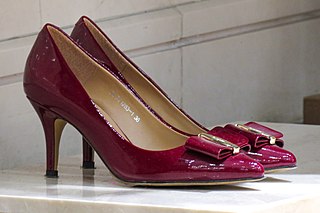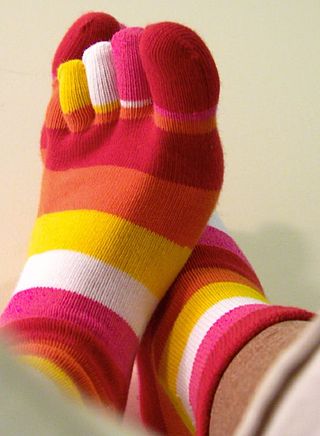
Footwear refers to garments worn on the feet,which typically serve the purpose of protection against adversities of the environment such as wear from rough ground;stability on slippery ground;and temperature.

Toes are the digits of the foot of a tetrapod. Animal species such as cats that walk on their toes are described as being digitigrade. Humans,and other animals that walk on the soles of their feet,are described as being plantigrade;unguligrade animals are those that walk on hooves at the tips of their toes.

Tabi are traditional Japanese socks worn with thonged footwear such as zori,dating back to the 15th century.

Jap is an English abbreviation of the word "Japanese". In some places,it is simply a contraction of the word and does not carry negative connotations,whereas in some other contexts it can be considered a slur.

Clogs are a type of footwear that has a thick,rigid sole typically made of wood,although in American English,shoes with rigid soles made of other materials are also called clogs.

Zori,also rendered as zōri,are thonged Japanese sandals made of rice straw,cloth,lacquered wood,leather,rubber,or—most commonly and informally—synthetic materials. They are a slip-on descendant of the tied-on waraji sandal.

Geta are traditional Japanese footwear resembling flip-flops. A kind of sandal,geta have a flat wooden base elevated with up to three "teeth",held on the foot with a fabric thong,which keeps the foot raised above the ground.

Waraji are light tie-on sandals,made from ropemaking fibers,that were the standard footwear of the common people in Japan.

Anti-Chinese sentiment is the fear or dislike of China,Chinese people and/or Chinese culture. In the western world,fear over the increasing economic and military power of China,its technological prowess and cultural reach,as well as international influence,has driven persistent and selectively negative media coverage of China. This is often aided and abetted by policymakers and politicians,whose actions are driven both by prejudice and expedience.

Anti-Japanese sentiment,a form of racism against Asians,involves the hatred or fear of anything which is Japanese,be it its culture or its people.

Sandals are an open type of shoe,consisting of a sole held to the wearer's foot by straps going over the instep and around the ankle. Sandals can also have a heel. While the distinction between sandals and other types of footwear can sometimes be blurry,the common understanding is that a sandal leaves all or most of the foot exposed. People may choose to wear sandals for several reasons,among them comfort in warm weather,economy,and as a fashion choice. Usually,people wear sandals in warmer climates or during warmer parts of the year in order to keep their feet cool and dry. The risk of developing athlete's foot is lower than with enclosed shoes,and the wearing of sandals may be part of the treatment regimen for such an infection.
Kotobagari is a sardonic term which refers to the reluctance to use words that are considered potentially offensive or politically incorrect in the Japanese language. For instance words such as rai,mekura,tsunbo,oshi,kichigai,tosatsujō,and hakuchi are currently not used by the majority of Japanese publishing houses;the publishers often refuse to publish writing which includes these words.

High-heeled shoes,also known as high heels,are a type of shoe with an upward-angled sole. The heel in such shoes is raised above the ball of the foot. High heels cause the legs to appear longer,make the wearer appear taller,and accentuate the calf muscle.

Toe socks are socks that have been knitted so that each toe is individually encased the same way as fingers within a glove.

Jika-tabi are a style of footwear with a divided toe,originating in Japan. They are similar to tabi socks in both appearance and construction. Though they can be worn with traditional thonged footwear such as geta and zōri,jika-tabi are mostly designed and made to be worn alone as outdoor footwear,resembling boots that reach roughly to the mid-calf. Jika-tabi are also known as 'tabi boots'.
Anti-Korean sentiment or Koryophobia describes negative feelings towards Korean people,Korean culture,or the countries,North Korea and/or South Korea.

Namaksin (Korean: 나막신) are traditional Korean wooden shoes made for wearing during muddy and rainy conditions. Namaksin are known as close-toed shoes made of one piece of wood. There was a misconception that these traditional clogs came not from Asia but from the Netherlands in the past,but in reality,there had been clogs at least from Three Kingdoms period of Korea,which were similar to geta,Japanese clogs. Those old namaksin were called "pyeonggeuk (平屐)". It is presumed that clogs of Baekje went to Japan,and it became the origin of geta. Clogs in Baekje had three holes like geta,but clogs in Silla had five holes. How people tied its strings in that era is unclear. In the Three Kingdoms period,there were two types of clogs:open-toes shoes,and close-toes shoes. As time went by,the latter became primary as namaksin. These shoes were worn by Koreans of all ages and social positions,usually in the rainy seasons.
Some historical Chinese characters for non-Han peoples were graphically pejorative ethnic slurs,where the racial insult derived not from the Chinese word but from the character used to write it. For instance,written Chinese first transcribed the name Yáo "the Yao people " with the character for yáo猺 "jackal". Most of those terms were replaced in the early 20th-century language reforms;for example,the character for the term yáo was changed,replaced this graphic pejorative meaning "jackal" with another one –a homophone meaning yáo瑤 "precious jade".
Anti-Vietnamese sentiment involves hostility or hatred that is directed towards Vietnamese people,or the state of Vietnam. This may be due to negative perceptions created by historical tensions,ethnic negative perceptions,wars,or xenophobic sentiments that emerged from the event of refugee Vietnamese. National or regional discrimination can also occur.

The toe box is the section of footwear that surrounds the toes on closed-toe shoes. Toe boxes that are too tight can cause injuries and foot deformities,whereas wider toe boxes may be used to treat or prevent common foot conditions such as broken toes,bunions,and Morton's neuroma. Toe boxes come in a variety of shapes and styles of construction,some of which are a matter of fashion,and some of which are designed for specialized functions.


















